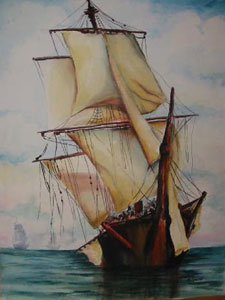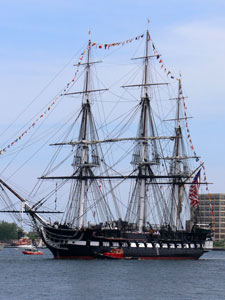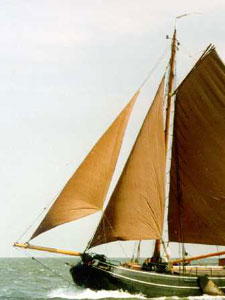Tea History: The John Company



For sheer majesty, the eighteenth and early nineteenth centuries offered few sights to compare with the a fleet of East Indiamen gliding down the English Channel, twenty or more great three-masters under clouds of canvas escorted by frigates of the Royal Navy busily flagging signals.
These fleets, like their crews and passengers, sailed under orders from India House in London, headquarters of John Company, officially The United Company of Merchants, of England Trading to the East Indies. By the mid-1700s the men of India House were not merchants, and they were not trading with India-in fact, they were not often united and not all Englishmen either. They were directors and managers of the most powerful economic force the world has ever seen. The consequences of their actions, great and small, are with us still today.
John Company came to be hated and loathed by smugglers and consumers alike as a symbol of corrupt, complacent monopoly. But it also founded the cities of Calcutta, Bombay, Singapore and Hong Kong. It hired Captain Kidd to combat piracy and made Elihu Yale the fortune with which to endow a university. Its corporate structure is the model for all joint stock companies to this day. The Stars and Stripes was inspired by its flag, the "typical" New England church patterned after its London chapel, and St. Petersburg modeled on its shipyards where Czar Peter the Great had worked incognito. It created British India, caused the Boston Tea Party and kept Napoleon captive on its island possession St. Helena. And this long-standing effort and enterprise was chiefly paid for by tea. The Company's fortunes came to rest on products destined to go down the drain in Europe and up in smoke in Asia.
Tea was in demand everywhere as soon as it was introduced, Europe or America, Indians or Laplanders, commoners or quality, but England's thirst for tea surpassed the rest. The first quantum leap in demand came after 1720 and has been linked to England's expanding imports of sugar from the Caribbean. In 1730 John Company imported over a million pounds of tea, four times more than a decade before, and realized profits in excess of one million pounds sterling. In 1760 tea imports reached almost three million pounds; in 1770, nine million. By 1801, England had thirty thousand wholesale or retail dealers in tea and the English were annually consuming two and one-half pounds of tea (and seventeen pounds of sugar) per capita. Tea thus became the Company's most profitable commodity by far and the value of the trade the Company conducted on its fifty yards of waterfront in Canton surpassed its revenue from the whole of India.
The ships which made possible such wealth and which connected this maritime empire were constructed to be both fortresses and floating warehouses. Up to the end of the 1700s the Company built its ships deep and wide not only to maximize cargo space but also to evade certain tax assessments. This "tea waggon" plowed through the water with a sickening lurch and at such slow speed that the round-trip to China required almost a year. Conditions on board were not the least of the hazards facing the thousand or more passengers who each year set out from England aboard such ships to tend to the business of the East India Company in Asia, packed like so many sardines amidst cargo, arms and provisions for the ship. By 1790 the Company was replacing and enlarging its 120 ship fleet with vessels which could stow almost twice as much cargo. That their lines and rigging virtually matched those of a seventy-four gun warship often proved useful in the twenty-three year contest with France to follow. The most famous case was in 1804.
The Company's returning China fleet laden with eight million pounds' worth of tea, silk and porcelain found an imposing French squadron laying in wait at the mouth of the Strait of Malacca (where fifteen years later Sir Stamford Raffles was to found Singapore for the Company). Commodore Nathaniel Dance had the Indiamen calmly form a line of battle and ordered the three leading ships to hoist the Royal Navy ensign instead of the Company's red and white stripes. All day and all night the French followed. "If the bold front put on by the enemy in the daytime had been a ruse," the French admiral wrote later, "he would have profited by the darkness to endeavor to conceal his escape. But I soon became convinced that this security was not feigned; three of his ships constantly kept their lights up, and the fleet continued to lie in order of battle throughout the night." Commodore Dance carried his desperate gamble right to the point of exchanging fire the following day and, when the French admiral lost his nerve and veered off, capped the hoax by signaling a general pursuit!
When Dance finally reached London exactly six months later he received a hero's welcome. He was knighted by George III, feted everywhere, and made a rich man by the Company which settled an annuity of five hundred pounds on him and appropriated fifty thousand for the officers and men of the sixteen ships in his convoy. In time this once proud fleet was sold off as scrap with the advent of clipper and, soon after, steamships. The last known East Indiaman was used until the 1920s as a dismasted coal hulk towed behind a tugboat at Gibraltar, the adventure and wealth of the tea trade forgotten. It could well symbolize the ruin the East India fleet had brought in its wake to China, the oldest civilization on the planet. The British flag at Canton, future Prime Minister Gladstone was to admit, "is hoisted to protect an infamous contraband traffic ... we should recoil from its sight with horror." None would feel this horror more keenly than the countless "Sons of the Yellow Emperor" who were reduced to leaving their Celestial Kingdom to serve as the world's coolies and suffer injury and discrimination everywhere, even in the child's rhyme:
Chink Chink, Chinaman, sitting on a rail, Along comes the white man and cuts off his tail...
